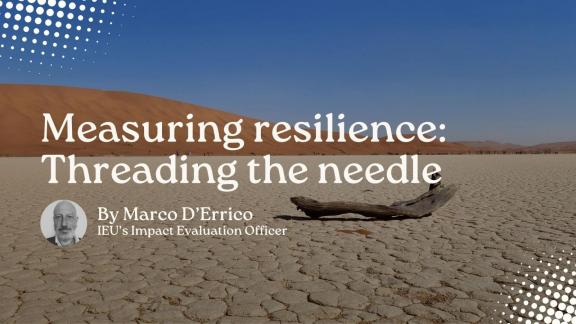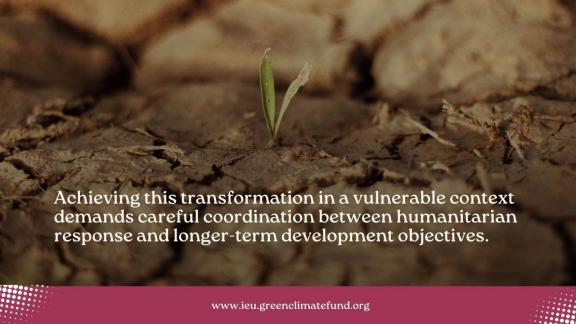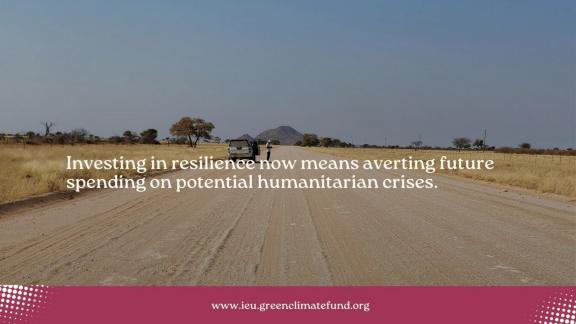Measuring resilience: Threading the needle
With the decision B.40/05, the Board approved the first GCF project in Somalia. This is quite an exciting challenge and a substantial discontinuity from the past. After working with and in Somalia quite often over the last 15 years, I felt deeply touched.
Somalia represents a critical case study in building climate resilience. The country has faced over 30 years of unceasing political and civil crises, consistently ranking among the world's most structurally vulnerable states. This political instability intersects with acute climate vulnerability, manifesting in degraded landscapes, declining pastoral systems, and low agricultural productivity. The 2011 drought in the country led to approximately 250,000 casualties and displaced over 1.3 million people internally while forcing 290,000 Somalis to flee to neighboring countries. When another severe drought struck in 2016-2017, affecting the crucial Gu and Deyr growing seasons, it caused massive livestock losses and displaced over 400,000 people, particularly to urban centers like Mogadishu and Baidoa.
While improved humanitarian coordination helped avert a widespread famine in 2016-2017, the experience highlighted the need for transformative approaches that address both immediate needs and long-term resilience. Achieving this transformation in a vulnerable context demands careful coordination between humanitarian response and longer-term development objectives, with programming that can adapt to evolving conditions while maintaining focus on systemic change. Within the large portfolio of impact evaluations under the IEU’s Learning-Oriented Real-Time Impact Assessment (LORTA) programme, the LORTA team will focus on the first ever GCF project in Somalia. Worth USD 80 million (plus 15m co-funding) over the next 6 years, executed by the Government of Somalia and FAO, the project will touch upon local institutions, local livelihoods, and restoration of rangelands. We are already designing the impact evaluation strategy, and I am thrilled to plan my next country-visit to Mogadishu.
What does it mean to invest in climate resilience in vulnerable and low resilience settings? Key questions might arise: ethical considerations (is it the priority?), practicality (is it feasible?), and sustainability (would it last?)
Although there is vast literature on resilience to climate effects in vulnerable settings, the best evidence it provides is on how complex it is to work in those environments. There is evidence on the main challenges; there is a good number of specific case studies; but often there is still a lack of clarity on what exactly it means to build climate change policies in areas where a conflict can abruptly emerge and instantly destroy all that has been built over time. We must distinguish between immediate climate shocks (like droughts) and long-term climate change effects (such as increased drought frequency), as each requires distinct response mechanisms and policies.
The final and perhaps the most important question is: what is the impact of the public and private money that is being invested in climate change policies?
When looking back at the decisions taken during UNFCCC COP29 it emerges even clearer: the New Collective Quantified Goal (NCQG) on climate finance decision agreed to triple finance to developing countries to USD 300 billion annually by 2035. Will this money have an impact? If so, on what exactly? And with what magnitude? This is particularly relevant when discussing climate resilience because of the numerous development and climate-related challenges mentioned above and because of the large portfolio of investments made and yet to be made. The more we (need to) invest, the more we need evidence of the impact of what we do.
The IEU will undertake work on climate resilience to establish a comprehensive framework encompassing the GCF’s portfolio of both mitigation and adaptation projects. This position paper will serve as the foundation for a focused workshop where leading experts will critically examine and enhance specific aspects of the framework, with particular attention to its practical application in impact evaluation. This initiative is crucial for four key reasons.
First, the GCF's significant investments—US$1.9 billion for health and food security and US$2.3 billion targeting vulnerable communities—require robust measurement frameworks to validate effectiveness and demonstrate concrete impact. Without standardized measurement approaches, it might be hard to justify continued investment or mobilize additional resources for adaptation, which currently represents only a fraction of global needs.
Second, climate resilience requires a multidimensional and context-specific framework that can capture both immediate results and long-term systemic changes. Ideally, this should happen under a coordinated effort that highly relies on partnerships. The UN system (UNFCCC, UNEP, UNDP), initiatives such as the Global Resilience Partnership or the Stockholm Resilience Center, and academic institutions can combine operational experience with analytical expertise to develop standardized measurement approaches. And secure the buy-in and endorsement.
Third, and perhaps most critically, the fund’s ability to mobilize additional resources for adaptation - which currently represents only a fraction of global needs - depends on demonstrating concrete evidence of impact.
Finally, resilience can help balance humanitarian and development investments by bridging the Humanitarian and Development (HD) nexus. Ultimately, investing in resilience now means averting future spending on potential humanitarian crises.
IEU’s future work includes a workshop that will bring all those aspects together to work at this framework and establish a common research and evaluation agenda for measuring and building climate resilience.
This institutional partnership model could establish a systematic approach where UN agencies and climate funds provide comprehensive project data, while research institutions contribute advanced analytical methodologies. Such collaboration would strengthen the evidence base for climate resilience interventions while ensuring methodological rigour in impact measurement. The resulting frameworks could serve as a foundation for more effective climate finance allocation and improved resilience outcomes across the international development community. And more effective climate finance is linked to a greater capacity to show impact.
When going to bed at night thinking about what I achieved during the day to tackle climate change and prevent further irreversible damage, three questions come to mind for me: 1) Does what we do in our daily work have any effect at all on the people that we are serving? 2) How can I answer this question if I do not have data-driven evidence? 3) And if I have the data, how shall I use it to make sure that what I claim is true?
With those questions in mind, I conclude my blog. I will stay ready, sipping a cup of good (Italian) coffee, and closely following the GCF Board deliberations at B.41.
Disclaimer: The views expressed in blogs are the author's own and do not necessarily reflect the views of the Independent Evaluation Unit of the Green Climate Fund. Names are changed for anonymity.



